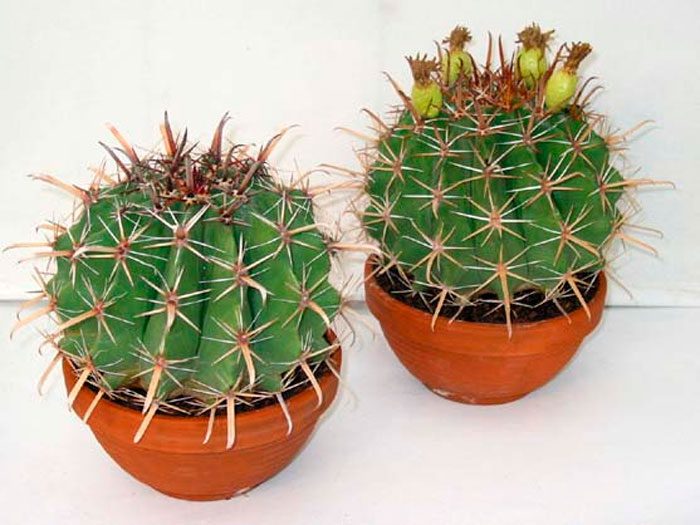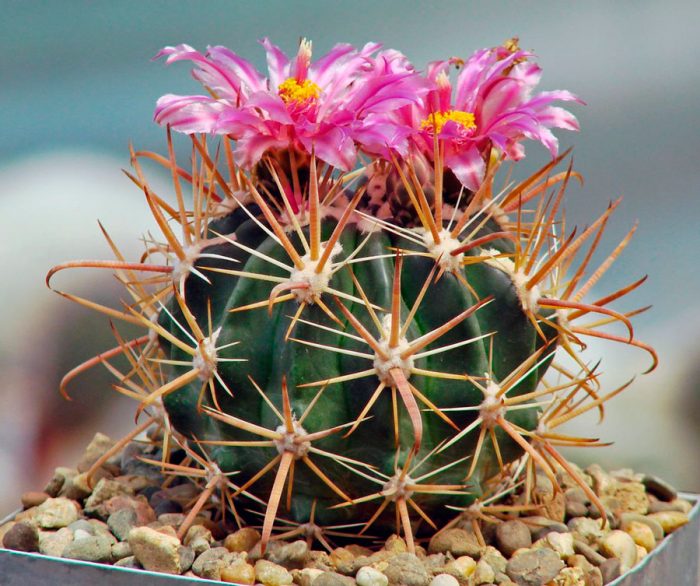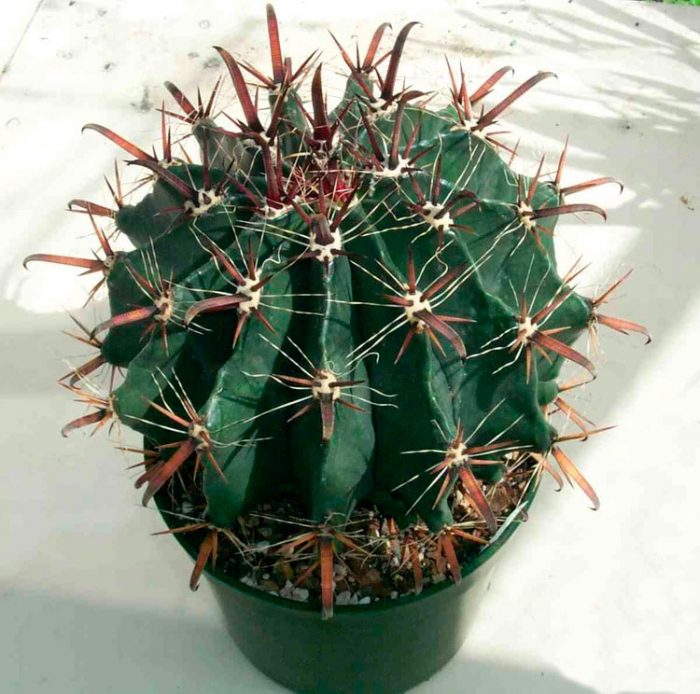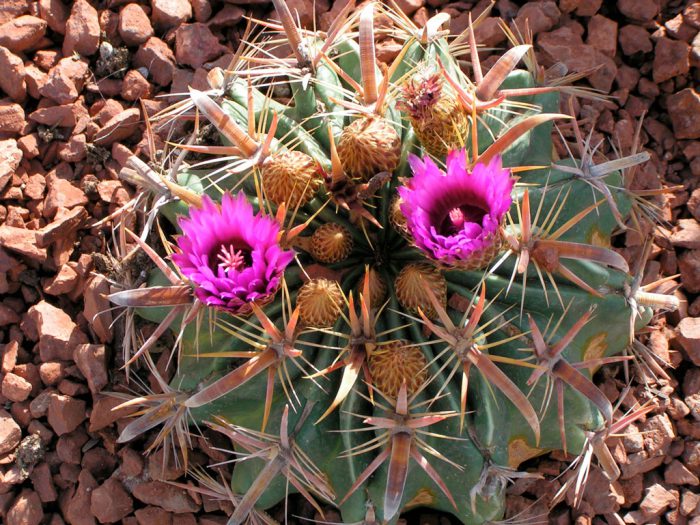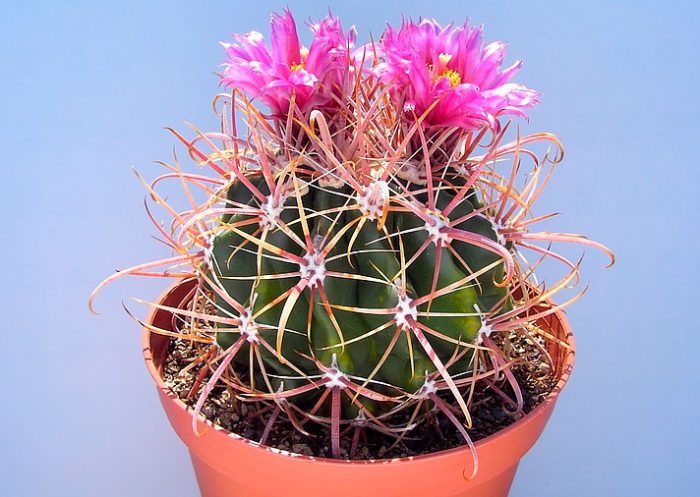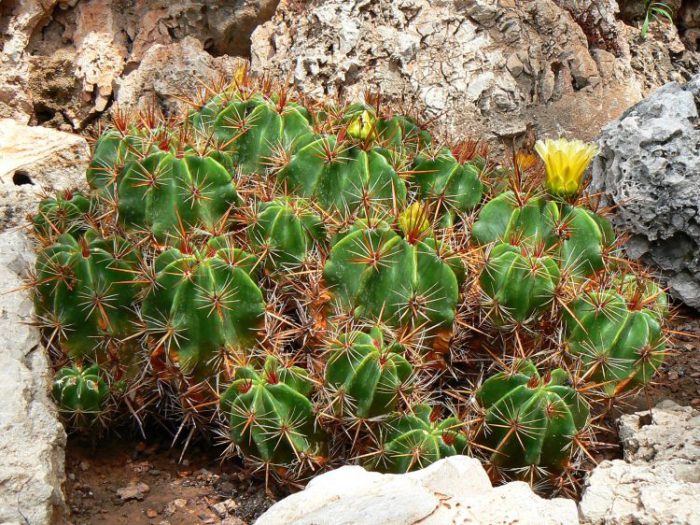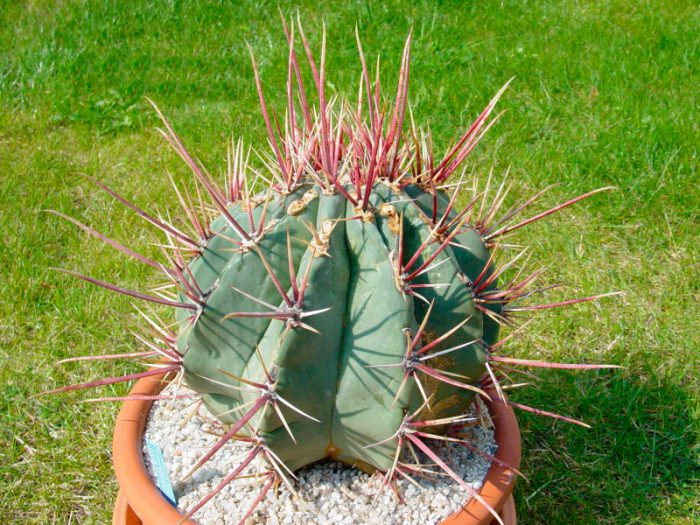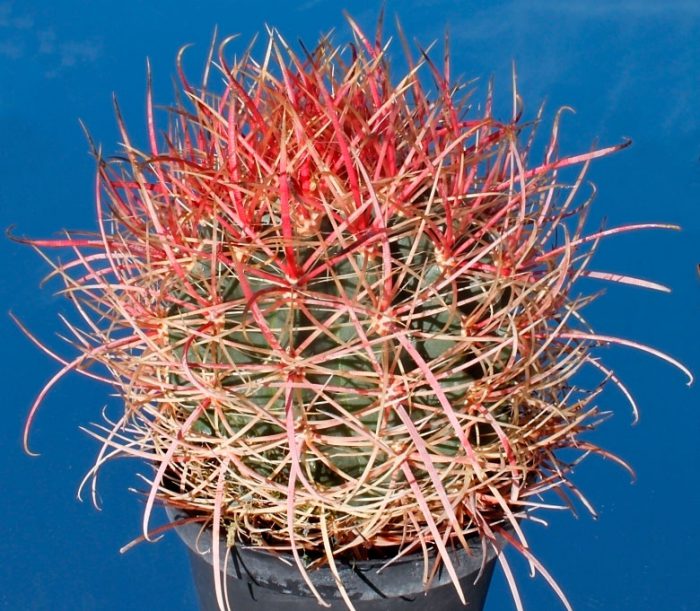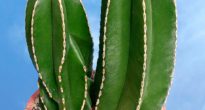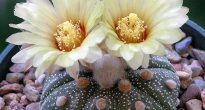Ferocactus (Ferocactus) - this genus is directly related to the cactaceae family (Cactaceae). It brings together more than 30 plant species. In nature, they can be found in the southwest of North America, as well as in the arid and desert regions of Mexico.
These plants, depending on the species, can have a very different shape. So, they can have a spherical or flattened shape, as well as elongated in a column. The stems are both single and covered with a large number of children. In height, they can reach both several tens of centimeters and four meters. There are species capable of forming quite extensive colonies. They can reach several meters in diameter and combine several hundred shoots.
Most often there are straight, thick ribs, which are also deeply cut. Areoles are rather large, pubescent, but there is no “cap” on the top of the cactus. This plant is distinguished by its long, powerful, hooked or curved spines, which are brightly colored and can reach 13 centimeters in length. There are species in which the thorns are flat (about 10 millimeters wide), in others they are awl-shaped.
Has underdeveloped roots. At the same time, the root system practically does not grow in depth, but only in breadth. Most often, the roots are buried in the ground by only 3 centimeters, but there are species in which the roots go into the soil by 20 centimeters.
Only adult cacti bloom, the height of which exceeds 25 centimeters. In this regard, the first flowering of ferocactus will have to wait for a long time.
The wide-open flowers have a rather short tube, which is covered with scales. Flowering occurs in summer, while several flowers bloom at once, located in the upper part of the stem.
Ferocactus care at home
This plant is quite undemanding to care for and not capricious.
Illumination
Place the cactus in a well-lit, sunny place. In this regard, it is recommended to put it on the sill of a south-facing window. In summer, it is recommended to move it to fresh air (to the balcony or to the garden).
If there is little light, then the needles become smaller and paler, while some part flies around.
Temperature regime
This plant is very fond of warmth and in summer it needs a temperature of 20 to 35 degrees.In winter, it should be placed in a fairly cool place (10 to 15 degrees). It should be noted that if the room is colder than 10 degrees, this can cause frostbite of the plant, as well as its death.
Ferocactus needs fresh air and therefore it is necessary to ventilate the room regularly, but this should be done with extreme caution, because it reacts extremely negatively to drafts.
How to water
Watering should be sparse. So, it is produced only after the substrate in the pot has completely dried. Water the plant with water at room temperature, which should be well settled.
From November to March, the plant can not be watered at all, but this is only if the room is quite cool. If the cactus hibernates in the warmth, then watering should be carried out in the same way as in the summer.
Humidity
It grows well at low air humidity, which is most often present in city apartments. You do not need to moisturize it, but you can carry out regular warm showers to remove accumulated dirt. For more effective cleaning, you can use a small paint brush or a soft toothbrush.
Earth mix
In the wild, this species of cactus prefers to grow on rocky or limestone soil. Under indoor conditions, for normal growth and development, you will need a similar soil, which should be porous, drained and sufficiently acidic (pH 7 or 8). To create a soil mixture at home, you will need to combine sod and leafy soil, fine gravel (can be replaced with brick chips) and coarse sand, which should be taken in equal proportions. To avoid the formation of rot on the root system, it is recommended to pour a small amount of charcoal into the ground.
You can use a commercially available dredge intended for cacti, but you must definitely add fine gravel or coarse sand to it.
Be sure to drain well to prevent stagnation of fluid in the ground.
Fertilizers
Ferocactus grows in nature on poor soils, in this regard, you should be very careful during feeding. So, they are carried out only once every 4 weeks. To do this, use a liquid fertilizer intended for succulents or cacti, while taking ½ part of the dose that is recommended on the package.
Reproduction methods
It is quite easy to grow from seeds. The same cacti that are "family" can be propagated by children.
Transplant features
Since this plant is slow-growing and has poorly developed roots, it should be replanted as rarely as possible. This procedure gives ferocactus a lot of inconvenience, since it will need to adapt to new conditions and take root. And the transplant procedure is complicated by the long thorns of the plant. In the event that the cactus itself is carried with thick gloves and a newspaper (wrapped around the stem), the thorns can easily break, which negatively affects its appearance.
Pests and diseases
The plant can settle spider mite, aphid or mealybug... After harmful insects are found on ferocactus, it will need to be exposed to a warm shower, while the plant must be washed with special care. Remember to cover the soil during the shower to avoid water ingress.
Treat the cactus with insecticides if a warm shower fails to get rid of the pests.
Most often, the plant gets sick as a result of the bay (especially during cold wintering). So, rot appears on its roots.
Main types
A large number of species are grown at home.
Wide-spiked ferocactus (Ferocactus latispinus)
It is also called "devil's tongue" - the most attractive species of this genus. The stem of such a cactus has a slightly flattened ball shape, while it is colored greenish-blue. There are 15 to 23 ribs that are quite tall.From areoles, which are large enough, come out from 2 to 4 ruby-red central wide spines, which reach 5-8 centimeters in length, as well as from 6 to 12 whitish-pink radial thin spines, the length of which is equal to 2 centimeters. The largest spine, like a tongue, is bent downward. In this regard, the plant is popularly nicknamed "devil's tongue". The large red flowers are bell-shaped and are up to 5 centimeters long. It is the smallest of all species, so the length and diameter of the plant does not exceed 40 centimeters.
Ferocactus Ford (Ferocactus fordii)
This species also does not stand out for its large size, its height does not exceed 40 centimeters. It is slightly similar to wide-spined ferocactus, the difference is in thin, pale central spines. The flowers reach 6 centimeters in diameter and are yellowish-red in color.
Ferocactus powerful (Ferocactus robustus)
This species has a very large number of children, as a result of which these cacti create rather dense and extensive "cushions" that can reach 1 meter in height and 5 meters in width. The dark green stem has the shape of a ball and 8 ribs. Brownish-red flat spines come in a variety of lengths.
Ferocactus rectispinus
The stem of a cylindrical shape can be up to 100 centimeters high, while the diameter is 35 centimeters. This species is distinguished by the longest spines (up to 25 centimeters). The spines themselves are brownish yellow, and their hooked tips are light pink. The diameter of the flowers is 5 centimeters, and they are painted in a pale yellow color.
Ferocactus cylindrical (Ferocactus acanthodes)
The cactus has an extremely unusual appearance, which is why it was nicknamed "the devil's pincushion". It has many very long radial spines, which in young plants overlap 1 or 2 adjacent ribs. They are strongly intertwined with each other while almost completely covering the cactus itself. The ten centimeter central spines give the cactus a very menacing look.
This plant is quite large. So, in height it can reach from 2 to 3 meters, and 60 centimeters wide. The stem is dark green, the thorns are red. The orange-yellow flowers have a diameter of 5 centimeters. In some cases, lateral children grow up in him, while not very large colonies are formed.
Interesting to know
This plant in the countries where it comes from is widely used for economic purposes. So, after preliminary drying, hollow stems are used as a container in which various products are stored, its pulp is eaten by livestock, and the needles are used as an awl or as hooks for fishing. And the cylindrical ferocactus can also become a kind of landmark, since its stems have a constant slope to the south.

